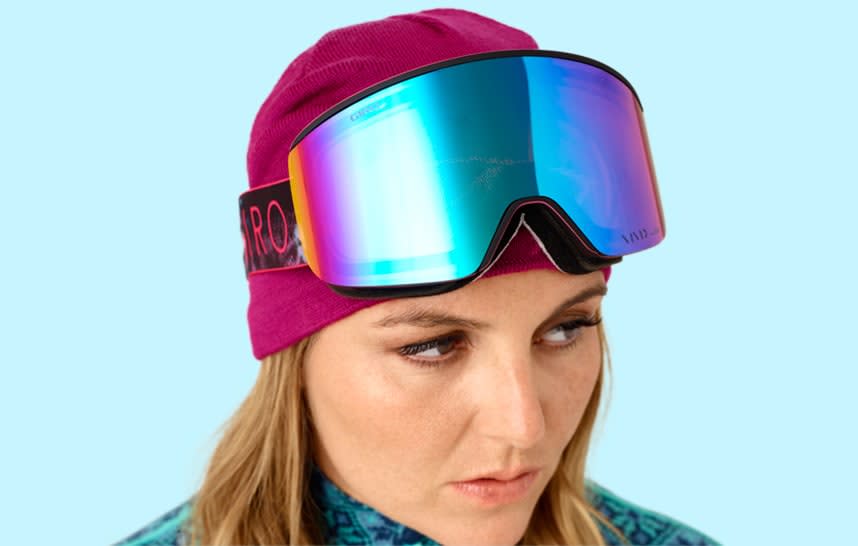Everything you need to know about buying ski goggles

From learning about lenses to top tips on fit, the lingo behind the latest ski and snowboard goggle technology will help with choosing the right pair for you.
Articulated hinges
The way the strap is attached to the goggle frame can make a difference to fit with a helmet - when they're joined by a plastic hinge that moves, rather than directly to the frame, the flexibility means pressure is spread more evenly across the face. That's partly why it pays to try out potential new goggles with your helmet.
Face foam
Foam forms a seal between you and the goggle frame, to protect against impact and the elements, and to wick moisture away from the skin. Most foam has three layers - extra soft next to the face for comfort, durable and solid next to the frame for protection, and malleable in the middle for better moulding to face contours. Some foam layers even have extra technology to help stop goggles steaming up.
Best ski goggles
Frameless
Some goggles have a much chunkier frame around the lens than others, and on some the frame is all but invisible from the front. This trimming down of the frame helps give wider peripheral vision even in smaller-sized goggles for smaller faces.
Helmet compatibility
All the goggles we review are compatible with helmets, but it's a good idea take yours with you when shopping because some frame shapes will fit it better than others. Also look out for a rubbery coating inside goggle straps to help grip on the helmet. Many goggle manufacturers now make helmets too, designed to work well with their goggles - vents may line up for example - but another brand may fit just as well and fit your head better.
Lens change system
When goggles come with two different lenses for different conditions, they need to be easy to swap in and out. Whether the system involves sliders or buttons on the frame, magnets, pins, or simply peeling back the frame, practise in the shop before you buy to see if you're happy with how easy it is and the time it takes to make sure the lens is solidly in position. Some of the most technical systems are easy to use while you're wearing them, which saves time.
Lens colour
As well as different coloured frames, most goggle models are available in various lens colours to suit different weather conditions. Yellow works well on cloudy days for example, allowing more light through the lens when the light is flat. Darker colours such as brown are good for sunny days, allowing less light through the lens. A lens's VLT (Visible Light Transmission) rating tells you how much light comes though. The lower the number, the more suitable for sunny days. Extra lens treatments such as polarisation or mirroring cut glare from the light reflected off bright snow, particularly valuable on sunny days. Many goggles now come with two lenses suiting different conditions, and the latest technology is superior lenses that allow a certain amount of blue light through, to boost contrast and definition in all conditions.
Lens shapes
There are two basic lens shapes. Spherical (rounded) lenses match the shape of the eye by curving both horizontally and vertically to give a more natural view. The latest toric versions vary the curves to give an even more realistic view. Cylindrical (flatter) lenses curve only vertically, as they bend into the frame. They are lower-profile than spherical lenses, and generally cost less, but peripheral vision may be distorted. The latest cylindrical lenses are injection moulded into their curve rather than shaped afterwards, to give better peripheral vision.
Ski boots: best for men
Photochromatic
Since some people find changing lenses a faff, photochromatic lenses that change quickly from light to dark and back as you ride have become more popular. As they've developed, the speed at which they change has improved and can happen within seconds.
UV and anti-fog protection
All the goggles we review screen out 100 per cent of harmful ultra-violet rays and have a lens coating that helps prevent fogging and scratches. Some have extra anti-fog features such as venting to prevent fog inside the lens, or a coating that repels water to prevent droplets forming on the lens. Protect the coatings by taking goggles off your helmet to store in their bag at the end of the day, and only cleaning them with a lens cloth. The included goggle bag usually doubles up as a cleaning cloth.
Venting
Extra vents on the frame and/or the lens can help air flow through goggles as you ride, to help prevent steaming up. The double lens featured on all but the most basic goggles helps too.

